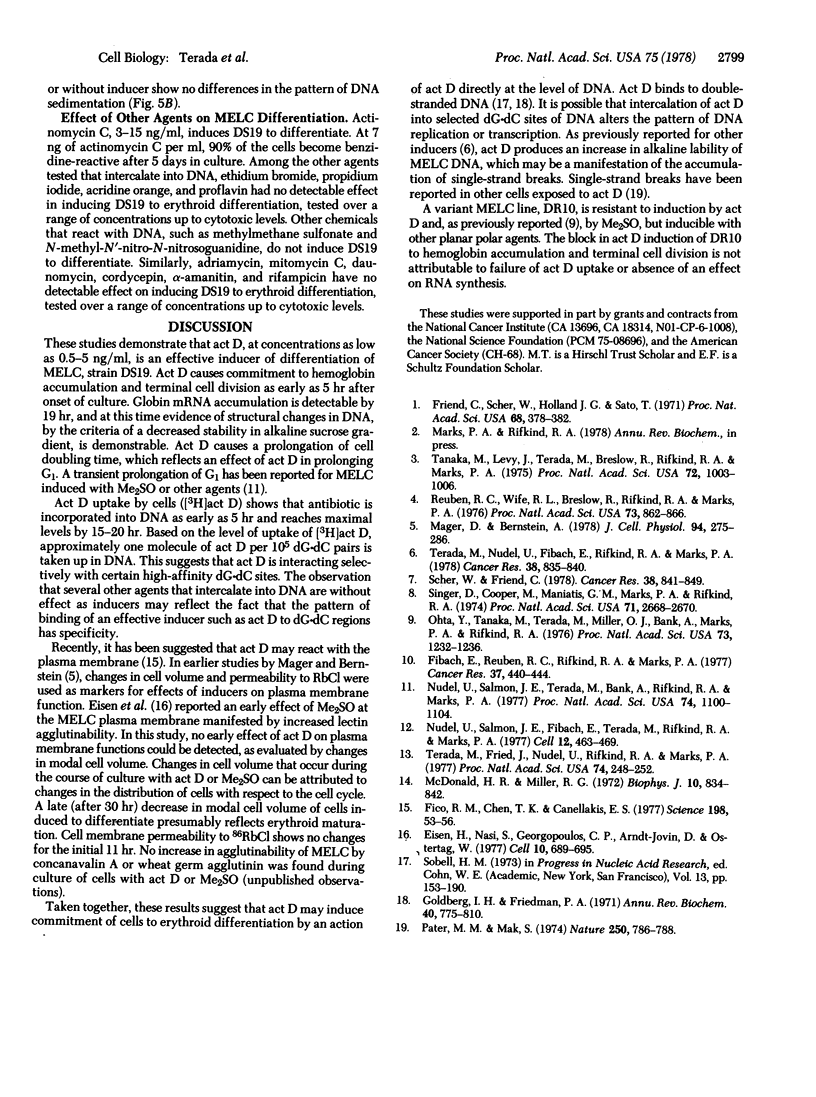Abstract
Murine erythroleukemia cells are induced to differentiate by 0.5-5 ng of actinomycin D per ml. Murine erythroleukemia cells cultured with actinomycin D prolong cell doubling time but achieve the same density after 5 days as cells without inducer. Actinomycin D causes over 95% of the cells to become benzidine-reactive. [3H]Actinomycin D uptake into DNA can be detected within 2 hr and reaches a maximum (approximately 0.1 pmol/106 cells) by 10-12 hr. It is estimated that about one out of 105 dG·dC pairs is bound to actinomycin D. Commitment to differentiation, assayed by transfer of cells to culture without inducer, was detected as early as 5 hr. Unlike Me2SO, which causes a transient prolongation in G1 at about 15-20 hr, cells cultured with actinomycin D show a more sustained increase in the proportion of the cells in G1. Globin mRNA accumulation was detectable by 19 hr in culture. Alteration in DNA stability in alkaline sucrose gradients was detected by 19 hr. Actinomycin D induces synthesis of Hbmaj and Hbmin in approximately equal amounts. A decrease in rates of synthesis of RNA, DNA, and total protein occurs in cells cultured with actinomycin D, as well as in cells cultured with Me2SO. No evidence for an early action of actinomycin D at the plasma membrane was obtained by measurement of changes in cell volume or 86RbCl uptake. Taken together, the present results indicate that actinomycin D is a potent inducer of differentiation of murine erythroleukemia cells and suggest that the target of its effect may be at the level of DNA.
Keywords: Friend cells, DNA, globin
Full text
PDF




Selected References
These references are in PubMed. This may not be the complete list of references from this article.
- Eisen H., Nasi S., Georgopoulos C. P., Arndt-Jovin D., Ostertag W. Surface changes in differentiating Friend erythroleukemic cells in culture. Cell. 1977 Apr;10(4):689–695. doi: 10.1016/0092-8674(77)90102-7. [DOI] [PubMed] [Google Scholar]
- Fibach E., Reuben R. C., Rifkind R. A., Marks P. A. Effect of hexamethylene bisacetamide on the commitment to differentiation of murine erythroleukemia cells. Cancer Res. 1977 Feb;37(2):440–444. [PubMed] [Google Scholar]
- Fico R. M., Chen T. K., Canellakis E. S. Bifunctional intercalators: relationship of antitumor activity of diacridines to the cell membrane. Science. 1977 Oct 7;198(4312):53–56. doi: 10.1126/science.897680. [DOI] [PubMed] [Google Scholar]
- Friend C., Scher W., Holland J. G., Sato T. Hemoglobin synthesis in murine virus-induced leukemic cells in vitro: stimulation of erythroid differentiation by dimethyl sulfoxide. Proc Natl Acad Sci U S A. 1971 Feb;68(2):378–382. doi: 10.1073/pnas.68.2.378. [DOI] [PMC free article] [PubMed] [Google Scholar]
- Goldberg I. H., Friedman P. A. Antibiotics and nucleic acids. Annu Rev Biochem. 1971;40:775–810. doi: 10.1146/annurev.bi.40.070171.004015. [DOI] [PubMed] [Google Scholar]
- Macdonald H. R., Miller R. G. Synchronization of mouse L-cells by a velocity sedimentation technique. Biophys J. 1970 Sep;10(9):834–842. doi: 10.1016/S0006-3495(70)86338-X. [DOI] [PMC free article] [PubMed] [Google Scholar]
- Mager D., Bernstein A. Early transport changes during erythroid differentiation of Friend leukemic cells. J Cell Physiol. 1978 Mar;94(3):275–285. doi: 10.1002/jcp.1040940305. [DOI] [PubMed] [Google Scholar]
- Nudel U., Salmon J. E., Terada M., Bank A., Rifkind R. A., Marks P. A. Differential effects of chemical inducers on expression of beta globin genes in murine erythroleukemia cells. Proc Natl Acad Sci U S A. 1977 Mar;74(3):1100–1104. doi: 10.1073/pnas.74.3.1100. [DOI] [PMC free article] [PubMed] [Google Scholar]
- Nudel U., Salmon J., Fibach E., Terada M., Rifkind R., Marks P. A., Bank A. Accumulation of alpha- and beta-globin messenger RNAs in mouse erythroleukemia cells. Cell. 1977 Oct;12(2):463–469. doi: 10.1016/0092-8674(77)90122-2. [DOI] [PubMed] [Google Scholar]
- Ohta Y., Tanaka M., Terada M., Miller O. J., Bank A., Marks P., Rifkind R. A. Erythroid cell differentiation: murine erythroleukemia cell variant with unique pattern of induction by polar compounds. Proc Natl Acad Sci U S A. 1976 Apr;73(4):1232–1236. doi: 10.1073/pnas.73.4.1232. [DOI] [PMC free article] [PubMed] [Google Scholar]
- Pater M. M., Mak S. Actinomycin D-induced breakage of human KB cell DNA. Nature. 1974 Aug 30;250(5469):786–788. doi: 10.1038/250786a0. [DOI] [PubMed] [Google Scholar]
- Reuben R. C., Wife R. L., Breslow R., Rifkind R. A., Marks P. A. A new group of potent inducers of differentiation in murine erythroleukemia cells. Proc Natl Acad Sci U S A. 1976 Mar;73(3):862–866. doi: 10.1073/pnas.73.3.862. [DOI] [PMC free article] [PubMed] [Google Scholar]
- Scher W., Friend C. Breakage of DNA and alterations in folded genomes by inducers of differentiation in Friend erythroleukemic cells. Cancer Res. 1978 Mar;38(3):841–849. [PubMed] [Google Scholar]
- Singer D., Cooper M., Maniatis G. M., Marks P. A., Rifkind R. A. Erythropoietic differentiation in colonies of cells transformed by Friend virus. Proc Natl Acad Sci U S A. 1974 Jul;71(7):2668–2670. doi: 10.1073/pnas.71.7.2668. [DOI] [PMC free article] [PubMed] [Google Scholar]
- Tanaka M., Levy J., Terada M., Breslow R., Rifkind R. A., Marks P. A. Induction of erythroid differentiation in murine virus infected eythroleukemia cells by highly polar compounds. Proc Natl Acad Sci U S A. 1975 Mar;72(3):1003–1006. doi: 10.1073/pnas.72.3.1003. [DOI] [PMC free article] [PubMed] [Google Scholar]
- Terada M., Fried J., Nudel U., Rifkind R. A., Marks P. A. Transient inhibition of initiation of S-phase associated with dimethyl sulfoxide induction of murine erythroleukemia cells to erythroid differentiation. Proc Natl Acad Sci U S A. 1977 Jan;74(1):248–252. doi: 10.1073/pnas.74.1.248. [DOI] [PMC free article] [PubMed] [Google Scholar]
- Terada M., Nudel U., Fibach E., Rifkind R. A., Marks P. A. Changes in DNA associated with induction of erythroid differentiation by dimethyl sulfoxide in murine erythroleukemia cells. Cancer Res. 1978 Mar;38(3):835–840. [PubMed] [Google Scholar]


